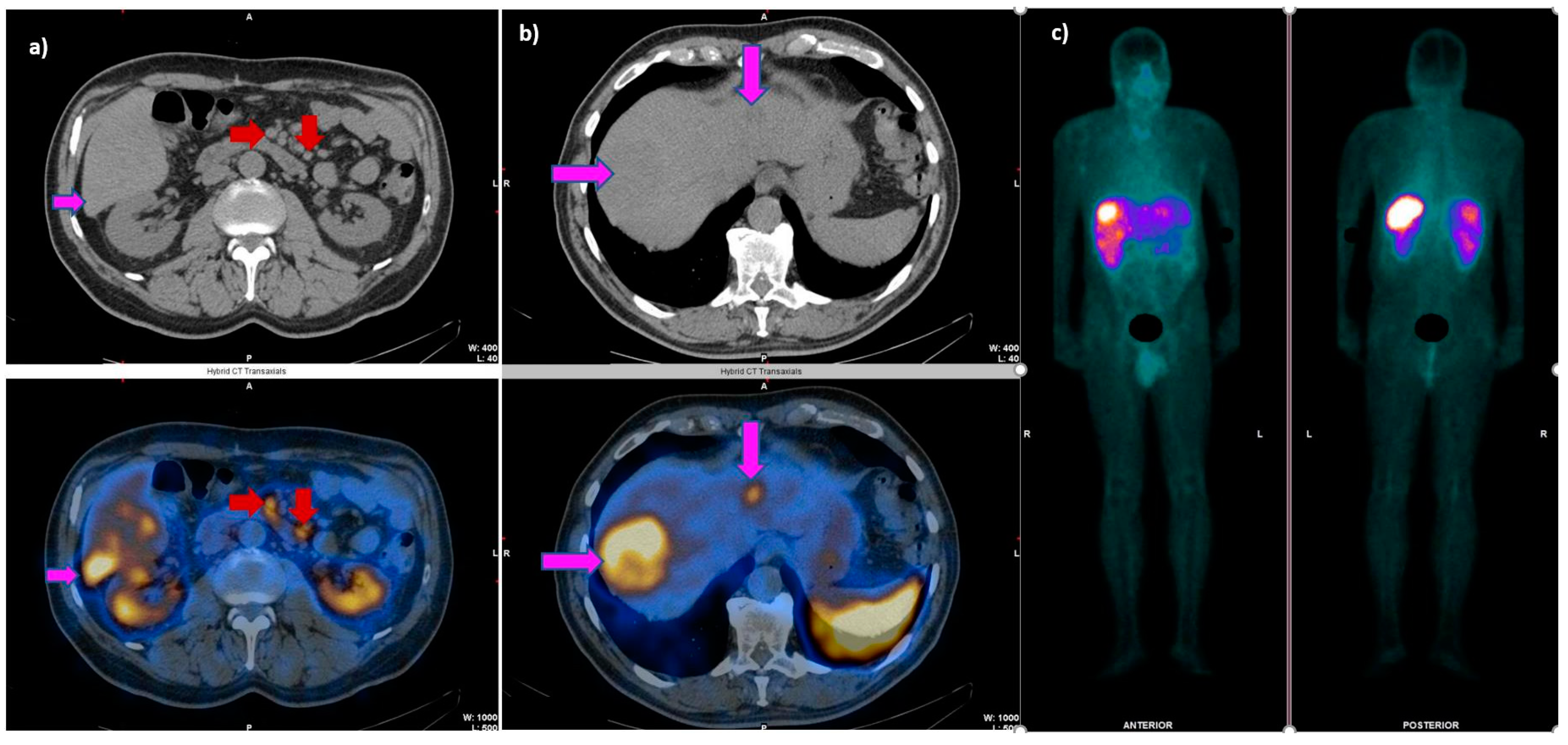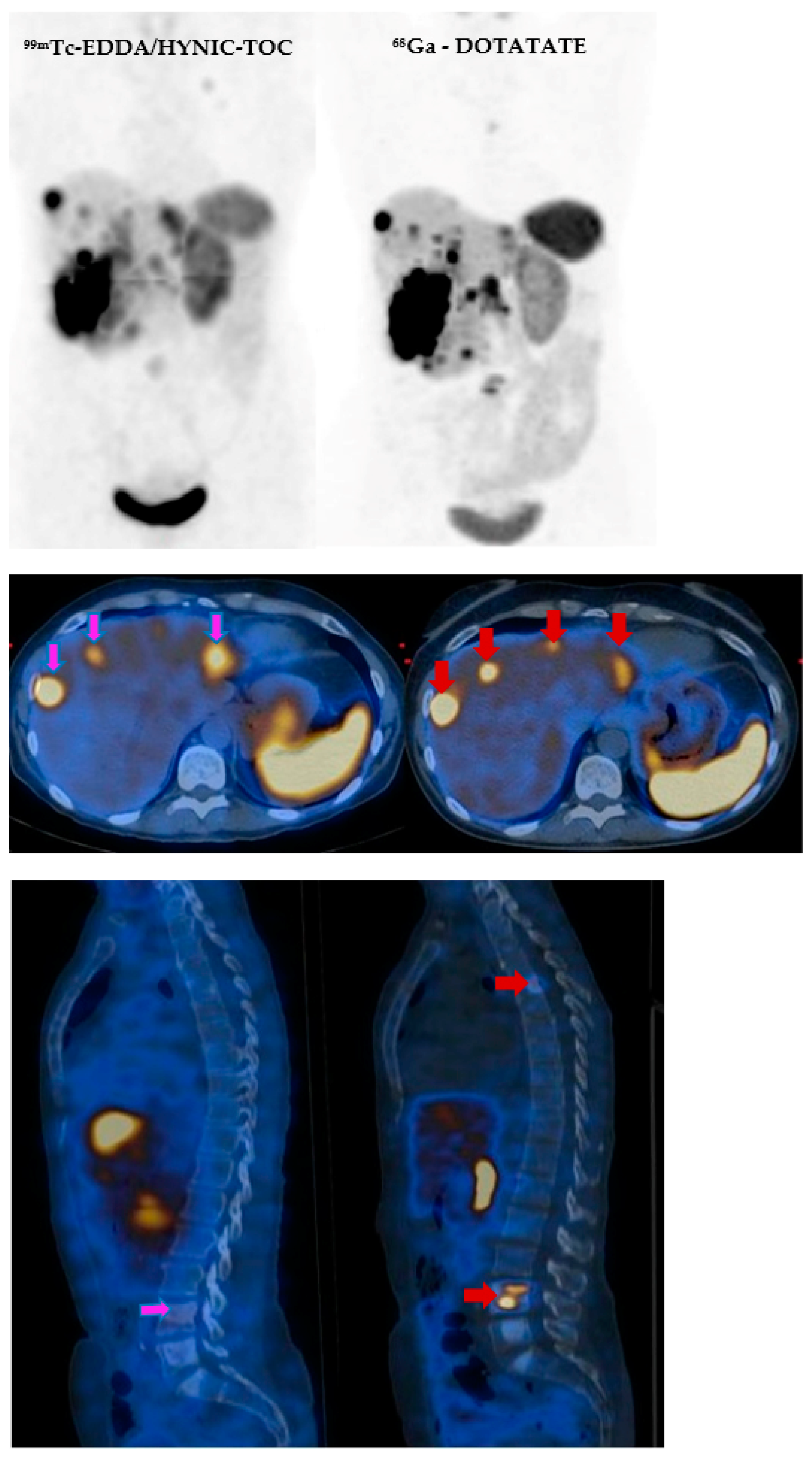The New Radiolabeled Peptide 99mTcEDDA/HYNIC-TOC: Is It a Feasible Choice for Diagnosing Gastroenteropancreatic NETs?
Abstract
:Simple Summary
Abstract
1. Introduction
2. Materials and Methods
2.1. Patient Selection
2.2. 99mTc-EDDA/HYNIC-TOC Synthesis
2.3. 99mTc-EDDA/HYNIC-TOC Radiochemical Purity
2.4. Acquisition Technique and Reconstruction
2.5. Image Analysis
2.6. Statistical Analysis
3. Results
4. Discussion
5. Conclusions
Author Contributions
Funding
Institutional Review Board Statement
Informed Consent Statement
Data Availability Statement
Conflicts of Interest
References
- Fraenkel, M.; Faggiano, A.; Valk, G.D. Epidemiology of Neuroendocrine Tumors. Neuroendocr. Tumors Multidiscip. Approach 2015, 44, 1–23. [Google Scholar] [CrossRef]
- Deroose, C.M.; Hindié, E.; Kebebew, E.; Goichot, B.; Pacak, K.; Taïeb, D.; Imperiale, A. Molecular Imaging of Gastroenteropancreatic Neuroendocrine Tumors: Current Status and Future Directions. J. Nucl. Med. 2016, 57, 1949–1956. [Google Scholar] [CrossRef] [PubMed] [Green Version]
- Nagtegaal, I.D.; Odze, R.D.; Klimstra, D.; Paradis, V.; Rugge, M.; Schirmacher, P.; Washington, K.M.; Carneiro, F.; Cree, I.A. The 2019 WHO Classification of Tumours of the Digestive System. Histopathology 2020, 76, 182–188. [Google Scholar] [CrossRef] [PubMed] [Green Version]
- Popa, O.; Taban, S.M.; Pantea, S.; Plopeanu, A.D.; Barna, R.A.; Cornianu, M.; Pascu, A.-A.; Dema, A.L.C. The New WHO Classification of Gastrointestinal Neuroendocrine Tumors and Immunohistochemical Expression of Somatostatin Receptor 2 and 5. Exp. Med. 2021, 22, 1179. [Google Scholar] [CrossRef]
- Klöppel, G. Neuroendocrine Neoplasms: Dichotomy, Origin and Classifications. Visc. Med. 2017, 33, 324–330. [Google Scholar] [CrossRef]
- Papotti, M.; Bongiovanni, M.; Volante, M.; Allìa, E.; Landolfi, S.; Helboe, L.; Schindler, M.; Cole, S.L.; Bussolati, G. Expression of Somatostatin Receptor Types 1-5 in 81 Cases of Gastrointestinal and Pancreatic Endocrine Tumors. A Correlative Immunohistochemical and Reverse-Transcriptase Polymerase Chain Reaction Analysis. Virchows Arch. 2002, 440, 461–475. [Google Scholar] [CrossRef]
- Baumann, T.; Rottenburger, C.; Nicolas, G.; Wild, D. Gastroenteropancreatic Neuroendocrine Tumours (GEP-NET)—Imaging and Staging. Best Pract. Res. Clin. Endocrinol. Metab. 2016, 30, 45–57. [Google Scholar] [CrossRef]
- Martin, S.; Fica, S.; Parfeni, O.; Popa, L.; Manuc, T.; Rizea, O.; Lupescu, I.; Gherghe, M.; Becheanu, G.; Croitoru, A. Somatostatinoma and Neurofibromatosis Type 1-A Case Report and Review of the Literature. Diagnostics 2020, 10, 620. [Google Scholar] [CrossRef]
- Martin, C.S.; Parfeni, O.D.; Popa, L.G.; Mihai, M.M.; Terzea, D.; Herlea, V.; Gherghe, M.; Adam, R.; Alnuaimi, O.; Calu, V.; et al. How Many Times Can One Go Back to the Drawing Board before the Accurate Diagnosis and Surgical Treatment of Glucagonoma? Diagnostics 2022, 12, 216. [Google Scholar] [CrossRef]
- Fonti, R.; Panico, M.; Pellegrino, S.; Pulcrano, A.; Vastarella, L.A.; Hakkak, A.; Giuliano, M.; Palmieri, G.; Placido, S.D.; Vecchio, S.D. Heterogeneity of SSTR2 Expression Assessed by 68Ga-DOTATOC PET/CT Using Coefficient of Variation in Patients with Neuroendocrine Tumors. J. Nucl. Med. 2022. Available online: https://jnm.snmjournals.org/content/early/2022/03/10/jnumed.121.262928 (accessed on 27 April 2022). [CrossRef]
- Andreasi, V.; Partelli, S.; Muffatti, F.; Manzoni, M.F.; Capurso, G.; Falconi, M. Update on Gastroenteropancreatic Neuroendocrine Tumors. Dig. Liver Dis. 2021, 53, 171–182. [Google Scholar] [CrossRef]
- del Olmo-Garcia, M.I.; Prado-Wohlwend, S.; Andres, A.; Soriano, J.M.; Bello, P.; Merino-Torres, J.F. Somatostatin and Somatostatin Receptors: From Signaling to Clinical Applications in Neuroendocrine Neoplasms. Biomedicines 2021, 9, 1810. [Google Scholar] [CrossRef] [PubMed]
- Briganti, V.; Cuccurullo, V.; Berti, V.; Di Stasio, G.D.; Linguanti, F.; Mungai, F.; Mansi, L. 99mTc-EDDA/HYNIC-TOC Is a New Opportunity in Neuroendocrine Tumors of the Lung (and in Other Malignant and Benign Pulmonary Diseases). Curr. Radiopharm. 2020, 13, 166–176. [Google Scholar] [CrossRef]
- Cascini, G.L.; Cuccurullo, V.; Tamburrini, O.; Rotondo, A.; Mansi, L. Peptide Imaging with Somatostatin Analogues: More than Cancer Probes. Curr. Radiopharm. 2013, 6, 36–40. [Google Scholar] [CrossRef] [PubMed]
- Mikołajczak, R.; Maecke, H.R. Radiopharmaceuticals for Somatostatin Receptor Imaging. Nucl. Med. Rev. 2016, 19, 126–132. [Google Scholar] [CrossRef] [PubMed] [Green Version]
- Lee, L.; Ito, T.; Jensen, R.T. Imaging of Pancreatic Neuroendocrine Tumors: Recent Advances, Current Status, and Controversies. Expert Rev. Anticancer Ther. 2018, 18, 837–860. [Google Scholar] [CrossRef]
- De Etchebehere, E.C.S.C.; de Santos, A.O.; Gumz, B.; Vicente, A.; Hoff, P.G.; Corradi, G.; Ichiki, W.A.; de Almeida Filho, J.G.; Cantoni, S.; Camargo, E.E.; et al. 68Ga-DOTATATE PET/CT, 99mTc-HYNIC-Octreotide SPECT/CT, and Whole-Body MR Imaging in Detection of Neuroendocrine Tumors: A Prospective Trial. J. Nucl. Med. 2014, 55, 1598–1604. [Google Scholar] [CrossRef] [Green Version]
- Reilly, C.; Gemmell, A.J.; McLaughlin, I.M.; Fleming, R.; Reed, N.; McIntosh, D.; Nicol, A. Characterisation of 99mTc EDDA/HYNIC-TOC (Tektrotyd) Physiological and Neuroendocrine Tumour Uptake Using SPECT/CT Standardised Uptake Values: Initial Experience. Nucl. Med. Commun. 2021, 42, 935–939. [Google Scholar] [CrossRef]
- Sergieva, S.; Robev, B.; Dimcheva, M.; Fakirova, A.; Hristoskova, R. Clinical Application of SPECT-CT with 99mTc-Tektrotyd in Bronchial and Thymic Neuroendocrine Tumors (NETs). Nucl. Med. Rev. 2016, 19, 81–87. [Google Scholar] [CrossRef] [Green Version]
- Trogrlic, M.; Težak, S. Incremental Value of 99mTc-HYNICTOC SPECT/CT over Whole-Body Planar Scintigraphy and SPECT in Patients with Neuroendocrine Tumours. Nuklearmedizin 2017, 56, 97–107. [Google Scholar] [CrossRef]
- Wang, J.; Rios, A.; Lisova, K.; Slavik, R.; Chatziioannou, A.F.; van Dam, R.M. High-throughput radio-TLC analysis. Nucl. Med. Biol. 2020, 82–83, 41–48. [Google Scholar] [CrossRef] [PubMed]
- Briganti, V.; Cuccurullo, V.; Di Stasio, G.D.; Mansi, L. Gamma Emitters in Pancreatic Endocrine Tumors Imaging in the PET Era: Is There a Clinical Space for 99mTc-Peptides? Curr. Radiopharm. 2019, 12, 156–170. [Google Scholar] [CrossRef] [PubMed]
- Saponjski, J.; Macut, D.; Petrovic, N.; Ognjanovic, S.; Popovic, B.; Bukumiric, Z.; Saranović, D.S. Diagnostic and Prognostic Value of 99mTc-Tektrotyd Scintigraphy and 18F-FDG PET/CT in a Single-Center Cohort of Neuroendocrine Tumors. Arch. Med. Sci. 2021. Available online: https://www.archivesofmedicalscience.com/Diagnostic-and-prognostic-value-of-99mTc-Tektrotyd-nscintigraphy-and-18F-FDG-PET,130996,0,2.html (accessed on 27 April 2022). [CrossRef]
- Artiko, V.; Afgan, A.; Petrović, J.; Radović, B.; Petrović, N.; Vlajković, M.; Šobić-Šaranović, D.; Obradović, V. Evaluation of Neuroendocrine Tumors with 99mTc-EDDA/HYNIC TOC. Nucl. Med. Rev. 2016, 19, 99–103. [Google Scholar] [CrossRef] [Green Version]
- Vlajković, M.; Rajić, M.; Ilić, S.; Stević, M.; Kojić, M.; Živković, V.; Karanikolić, A.; Matović, M. The Influence of Ki-67 Proliferation Index on Tc-99m-EDDA-HYNIC-TOC Somatostatin Receptor Scintigraphy in Patients with Carcinoids. Open Chem. 2015, 13, 339–345. [Google Scholar] [CrossRef]
- Kunikowska, J.; Lewington, V.; Krolicki, L. Optimizing Somatostatin Receptor Imaging in Patients with Neuroendocrine Tumors: The Impact of 99mTc-HYNICTOC SPECT/SPECT/CT Versus 68Ga-DOTATATE PET/CT Upon Clinical Management. Clin. Nucl. Med. 2017, 42, 905–911. [Google Scholar] [CrossRef]
- Deppen, S.A.; Blume, J.; Bobbey, A.J.; Shah, C.; Graham, M.M.; Lee, P.; Delbeke, D.; Walker, R.C. 68Ga-DOTATATE Compared with 111In-DTPA-Octreotide and Conventional Imaging for Pulmonary and Gastroenteropancreatic Neuroendocrine Tumors: A Systematic Review and Meta-Analysis. J. Nucl. Med. 2016, 57, 872–878. [Google Scholar] [CrossRef] [Green Version]
- Rust, E.; Hubele, F.; Marzano, E.; Goichot, B.; Pessaux, P.; Kurtz, J.-E.; Imperiale, A. Nuclear Medicine Imaging of Gastro-Entero-Pancreatic Neuroendocrine Tumors. The Key Role of Cellular Differentiation and Tumor Grade: From Theory to Clinical Practice. Cancer Imaging 2012, 12, 173–184. [Google Scholar] [CrossRef] [Green Version]
- Koçyiğit Deveci, E.; Ocak, M.; Bozkurt, M.F.; Türker, S.; Kabasakal, L.; Uğur, Ö. The Diagnostic Efficiency of 99mTc-EDDA/HYNIC-Octreotate SPECT-CT in Comparison with 111In-Pentetrotide in the Detection of Neuroendocrine Tumours. Mol. Imaging Radionucl. Ther. 2013, 22, 76–84. [Google Scholar] [CrossRef]
- Lee, I.; Paeng, J.C.; Lee, S.J.; Shin, C.S.; Jang, J.-Y.; Cheon, G.J.; Lee, D.S.; Chung, J.-K.; Kang, K.W. Comparison of Diagnostic Sensitivity and Quantitative Indices Between 68Ga-DOTATOC PET/CT and 111In-Pentetreotide SPECT/CT in Neuroendocrine Tumors: A Preliminary Report. Nucl. Med. Mol. Imaging 2015, 49, 284–290. [Google Scholar] [CrossRef] [Green Version]





| Age (Mean ± SD) | 55 ± 13.36 | ||
|---|---|---|---|
| Number | Percentage | ||
| Sex | F | 98 | 56.6% |
| M | 75 | 43.4% | |
| NET localization | Stomach | 20 | 11.6% |
| Small Bowel | 69 | 39.9% | |
| Large Bowel | 9 | 5.2% | |
| Appendix | 4 | 2.3% | |
| Pancreas | 71 | 41% | |
| Tumor grade | NET G1 | 81 | 46.8% |
| NET G2 | 62 | 35.8% | |
| NET G3 | 3 | 1.7% | |
| NA | 27 | 15.6% |
| Immunohistochemical Marker | Positivity Rate (%) |
|---|---|
| CGA | 78.6 |
| SYN | 66.5 |
| CDX2 | 12.7 |
| NSE | 16.8 |
| CD56 | 16.2 |
| Biochemical Marker | Positivity Rate (%) |
|---|---|
| Serotonin | 23.1 |
| Gastrin | 9.9 |
| Insulin | 1.7 |
| Glucagon | 1.7 |
| 5-HIAA | 11 |
| Obtained Value | |
|---|---|
| Sensitivity | 90.5% |
| Specificity | 71.9% |
| Accuracy | 84.3% |
| PPV | 86.7% |
| NPV | 78.8% |
Publisher’s Note: MDPI stays neutral with regard to jurisdictional claims in published maps and institutional affiliations. |
© 2022 by the authors. Licensee MDPI, Basel, Switzerland. This article is an open access article distributed under the terms and conditions of the Creative Commons Attribution (CC BY) license (https://creativecommons.org/licenses/by/4.0/).
Share and Cite
Gherghe, M.; Lazăr, A.M.; Stanciu, A.E.; Mutuleanu, M.-D.; Sterea, M.-C.; Petroiu, C.; Galeș, L.N. The New Radiolabeled Peptide 99mTcEDDA/HYNIC-TOC: Is It a Feasible Choice for Diagnosing Gastroenteropancreatic NETs? Cancers 2022, 14, 2725. https://doi.org/10.3390/cancers14112725
Gherghe M, Lazăr AM, Stanciu AE, Mutuleanu M-D, Sterea M-C, Petroiu C, Galeș LN. The New Radiolabeled Peptide 99mTcEDDA/HYNIC-TOC: Is It a Feasible Choice for Diagnosing Gastroenteropancreatic NETs? Cancers. 2022; 14(11):2725. https://doi.org/10.3390/cancers14112725
Chicago/Turabian StyleGherghe, Mirela, Alexandra Maria Lazăr, Adina Elena Stanciu, Mario-Demian Mutuleanu, Maria-Carla Sterea, Cristina Petroiu, and Laurenția Nicoleta Galeș. 2022. "The New Radiolabeled Peptide 99mTcEDDA/HYNIC-TOC: Is It a Feasible Choice for Diagnosing Gastroenteropancreatic NETs?" Cancers 14, no. 11: 2725. https://doi.org/10.3390/cancers14112725






